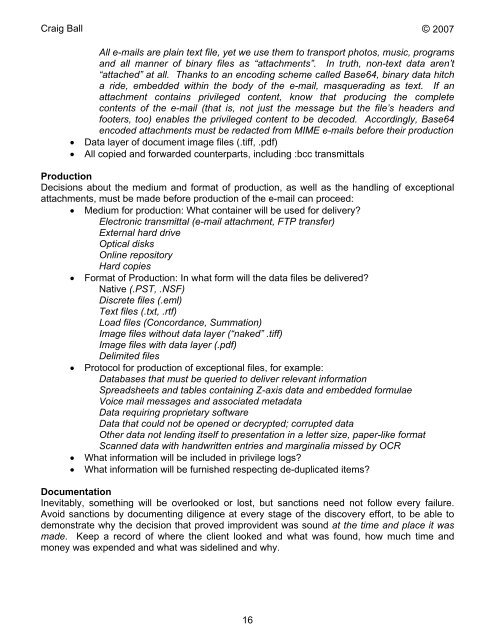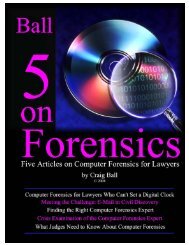Six Articles on Electronic - Craig Ball
Six Articles on Electronic - Craig Ball
Six Articles on Electronic - Craig Ball
Create successful ePaper yourself
Turn your PDF publications into a flip-book with our unique Google optimized e-Paper software.
<strong>Craig</strong> <strong>Ball</strong> © 2007<br />
All e-mails are plain text file, yet we use them to transport photos, music, programs<br />
and all manner of binary files as “attachments”. In truth, n<strong>on</strong>-text data aren’t<br />
“attached” at all. Thanks to an encoding scheme called Base64, binary data hitch<br />
a ride, embedded within the body of the e-mail, masquerading as text. If an<br />
attachment c<strong>on</strong>tains privileged c<strong>on</strong>tent, know that producing the complete<br />
c<strong>on</strong>tents of the e-mail (that is, not just the message but the file’s headers and<br />
footers, too) enables the privileged c<strong>on</strong>tent to be decoded. Accordingly, Base64<br />
encoded attachments must be redacted from MIME e-mails before their producti<strong>on</strong><br />
• Data layer of document image files (.tiff, .pdf)<br />
• All copied and forwarded counterparts, including :bcc transmittals<br />
Producti<strong>on</strong><br />
Decisi<strong>on</strong>s about the medium and format of producti<strong>on</strong>, as well as the handling of excepti<strong>on</strong>al<br />
attachments, must be made before producti<strong>on</strong> of the e-mail can proceed:<br />
• Medium for producti<strong>on</strong>: What c<strong>on</strong>tainer will be used for delivery?<br />
Electr<strong>on</strong>ic transmittal (e-mail attachment, FTP transfer)<br />
External hard drive<br />
Optical disks<br />
Online repository<br />
Hard copies<br />
• Format of Producti<strong>on</strong>: In what form will the data files be delivered?<br />
Native (.PST, .NSF)<br />
Discrete files (.eml)<br />
Text files (.txt, .rtf)<br />
Load files (C<strong>on</strong>cordance, Summati<strong>on</strong>)<br />
Image files without data layer (“naked” .tiff)<br />
Image files with data layer (.pdf)<br />
Delimited files<br />
• Protocol for producti<strong>on</strong> of excepti<strong>on</strong>al files, for example:<br />
Databases that must be queried to deliver relevant informati<strong>on</strong><br />
Spreadsheets and tables c<strong>on</strong>taining Z-axis data and embedded formulae<br />
Voice mail messages and associated metadata<br />
Data requiring proprietary software<br />
Data that could not be opened or decrypted; corrupted data<br />
Other data not lending itself to presentati<strong>on</strong> in a letter size, paper-like format<br />
Scanned data with handwritten entries and marginalia missed by OCR<br />
• What informati<strong>on</strong> will be included in privilege logs?<br />
• What informati<strong>on</strong> will be furnished respecting de-duplicated items?<br />
Documentati<strong>on</strong><br />
Inevitably, something will be overlooked or lost, but sancti<strong>on</strong>s need not follow every failure.<br />
Avoid sancti<strong>on</strong>s by documenting diligence at every stage of the discovery effort, to be able to<br />
dem<strong>on</strong>strate why the decisi<strong>on</strong> that proved improvident was sound at the time and place it was<br />
made. Keep a record of where the client looked and what was found, how much time and<br />
m<strong>on</strong>ey was expended and what was sidelined and why.<br />
16













